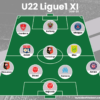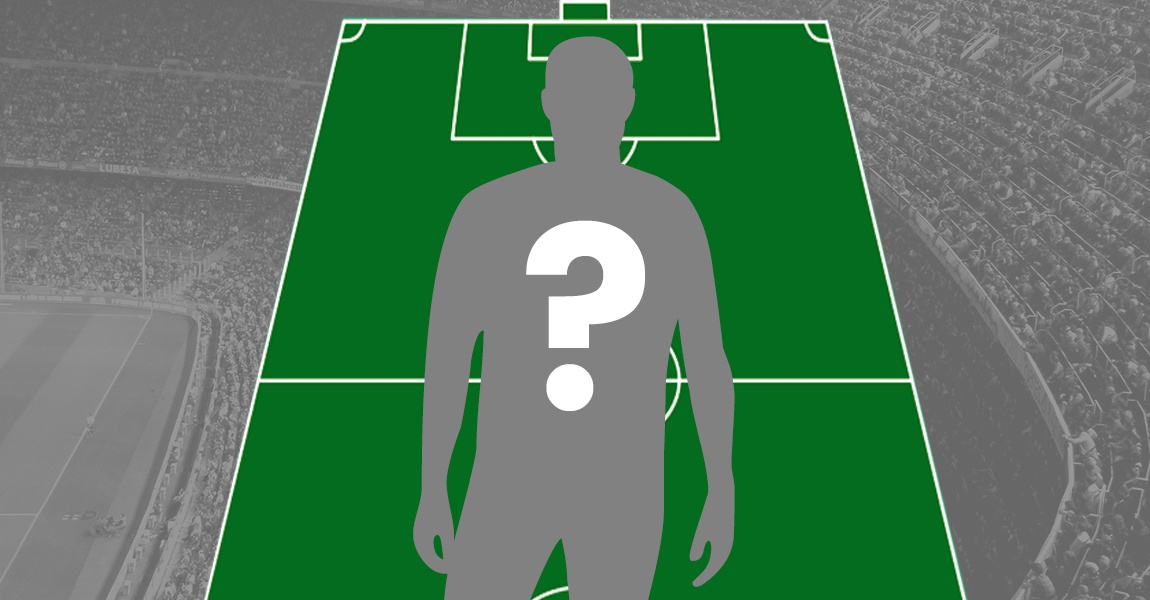Ervin Ang writes a detailed tactical analysis about the Ligue 1 match that ended PSG 2-2 Nice.
A David versus Goliath matchup. Nice came into this fixture three points clear of nearest rivals Monaco, and four ahead of PSG. Yet, it was the league leaders that represented David, both on paper and on the pitch, for this match in solitude. The visitors were without key central defender Paul Baysse, ruled out with a knee injury. Mario Balotelli was only fit enough to be named on the bench by Lucien Favre. The Swiss tactician chose to set his team up in a 5-3-2 shape, happy to cede possession and hit PSG on the counter. Arnaud Souquet came in for the injured Baysse, while young central midfielder Remi Walter retained his place ahead of Vincent Koziello. Younes Belhanda partnered Alassane Plea upfront in Balotelli’s absence.
Unai Emery’s PSG came into this tie knowing fully a win was necessary, on the back of last weekend’s humiliating 3-0 defeat at the hands of Montpellier, as well as failing to overcome minnows Ludogrets in a midweek Champions League tie. Emery’s team selection sparked major furore, as an out-of-form Blaise Matuidi was picked to start at left-wing, ahead of the significantly greater technically-gifted Lucas Moura or Hatem Ben Arfa. Marco Verratti returned at the expense of 19-year old Christopher Nkunku, while Thiago Motta replaced Lucas Moura. Le Parisiens set-up in their usual 4-3-3 shape, one that Emery has always been a huge advocate of.
Line Ups:
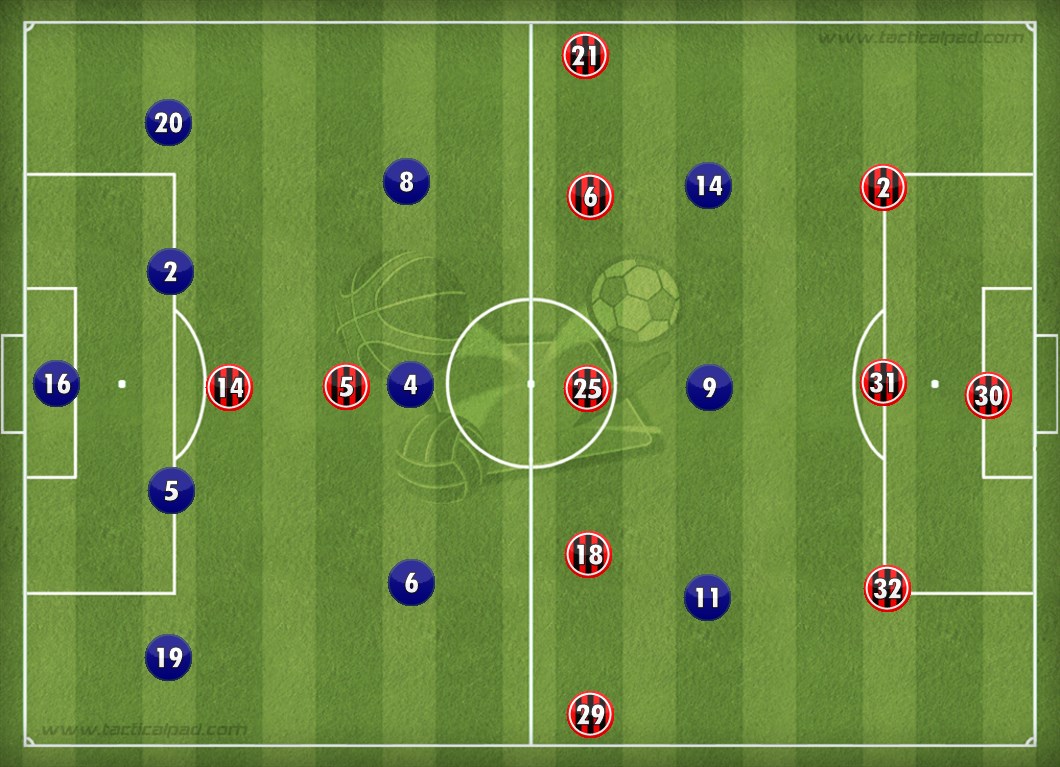
Made using TacticalPad
Paris Saint Germain (PSG): 16.Areola 19.Aurier 5.Marquinhos 2.Silva 20.Kurzawa 6.Verratti 4.Krychowiak 8.Motta 11.Di Maria 9.Cavani 14.Matuidi
Nice: 30.Cardinale 21.Pereira 2.Souquet 31.Dante 32.Sarr 29.Dalbert 6.Seri 25.Cyprien 18.Walter 5.Belhanda 19.Plea
Nice’s poor start
PSG started off on the front foot, dominating possession early on, fashioning a few good chances out of the situations they were able to play out of Nice’s indecisiveness and lack of intensity pressing PSG deep into their half.
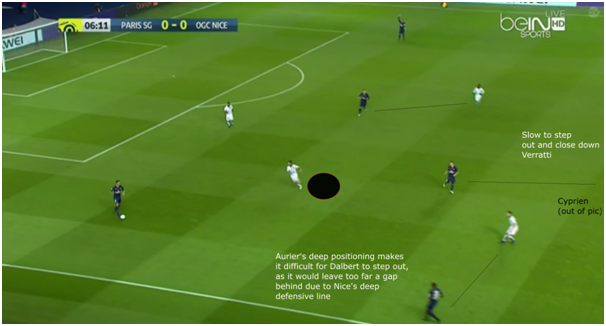
Scenario 1: Nice’s low-intensity high press
As can be seen from this scenario, Nice’s high press is far too weak. The pressing distance of their players is too far to put pressure on, and eliminate any of PSG’s potential receivers here as options to progress play towards. It is quite clear the trigger for Nice to shift to high-pressing is ambiguous, as Cyprien is slow to step out to close down Verratti. Favre’s choice to stray away from man-orientations off the ball, preferring to defend in more of a zonal approach, proved its flaws in the away side’s inability to limit PSG’s first-phase build up. Additionally, the Nice backline was unwilling to commit to a high line, leaving perilous space in between the lines, with bad defensive access in a poorly supported high press.
In a zonal-marking system, some confusion may occur in individual player roles – understanding which player to press in their area of coverage, in relation to their teammates; made harder as players drift in and out of zones concurrently. The delay in recognizing which player to pick up was enough to allow PSG to play out via Aurier, in this scenario. One advantage of applying a man-oriented defensive style is the ease of organization, especially in coordinating a high press.
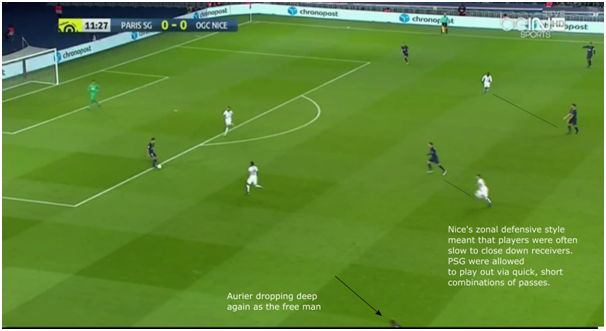
Scenario 2: PSG allowed to play out comfortably
The above image shows another situation, where Nice were caught out, in their lacklustre high press. Marquinhos receives and there are options aplenty for him to play forward, with Motta, Krychowiak, Aurier available without any immediate pressure. Aurier once again drops deep to act as the free man to play out from the back, as he is found with a wall pass from Krychowiak.
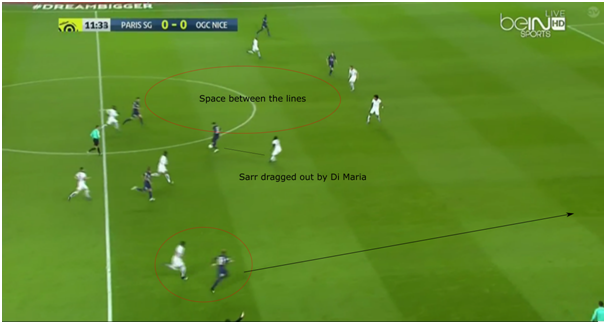
As the home side manage to smoothly bypass Nice’s first two lines of pressure, the space allowed between the lines is exposed. Also, Dalbert’s indecisiveness in picking up Aurier often leaves him on the back foot, allowing Aurier space to sprint forward and receive. A common movement pattern PSG use to penetrate down the flanks is briefly displayed here. Di Maria comes inside, dragging his marker (Sarr) with him, creating space in behind for Aurier to bomb forward.
PSG’s problems in possession – Flank-oriented build up
Favre’s Nice were successful in preventing PSG opportunities to penetrate through the centre, with a compact defensive line, and a narrow midfield unit that ensured horizontal compactness as they shifted in unison, with the ball as their reference point.
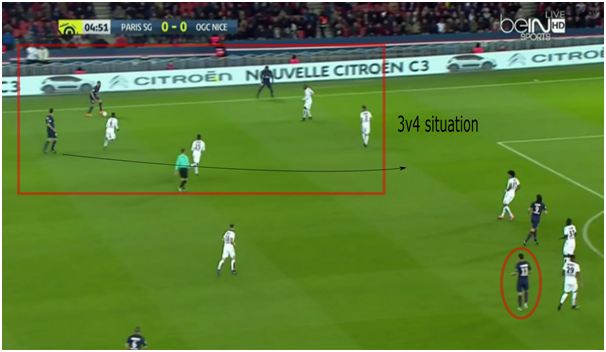
Scenario 3: PSG’s poor spacing on the flanks
As shown in this scenario in the first half, PSG failed to create overloads on the flank and even got outnumbered at times. Emery played into the hands of Favre, who is famed for setting up his team to press the immediate space around the position of the ball (to be covered later). The wide central midfielder (Motta here), was often too static, not getting involved and failing to make penetrative runs to open the Nice defence, exploiting the gap between the ball-side centre-back (Souquet) and the middle centre-back (Dante), as indicated by the arrow above. PSG had to rely on swift give-and-gos, one-twos, between the full-back and winger, to penetrate. Matuidi’s inability to beat Pereira 1v1 also meant that PSG were largely predictable down the left flank. Emery’s insistence on structured positional play, even in the final third, shows from Di Maria’s positioning (red circle). Perhaps, he could’ve been allowed to drift to the left, to offer another option to penetrate, by running the aforementioned channel (RCB-MCB, between Souquet and Dante).
Serge Aurier was a lethal weapon in penetrating Nice down the right flank, even without numerical superiority out wide. His frequent late runs from deep gave him the momentum to go past his marker (Dalbert), receiving in good positions to deliver crosses, which Nice custodian Cardinale largely struggled with throughout the game. This was perhaps a clear weakness Emery’s side targeted at exploiting through their flank-oriented offensive approach. Di Maria’s quality with the ball at his feet allowed him to beat his marker (LCB-Sarr) on a few occasions, as well as combine more effectively with Aurier down the right flank – qualitative superiority. Verratti dropping into a deeper position allowed him time and space to play Aurier through on numerous occasions. It was a move that allowed PSG to pull a goal back right after the break.
Favre’s spatial overloads in midfield – Flank-trapping
Lucien Favre’s Borussia Monchengladbach side was well-known for their unique defensive approach, namely – focusing on lateral shifts to restrict the immediate space around the ball, or overloading space. The current Nice manager was happy to concede space on the ball-far flank, even with opposition players stationed in those areas with no one within pressing distance. The underlying philosophy to this seemingly risky approach is simple. Even if the opponent has players occupying dangerous positions in the final third, on the ball-far flank, it does not hurt Favre’s men as long as they ensure the ball does not reach them.
Just months into his tenure at the Allianz Riviera, Le Aiglons have shown signs of adaptation to their new bosses’ methods.
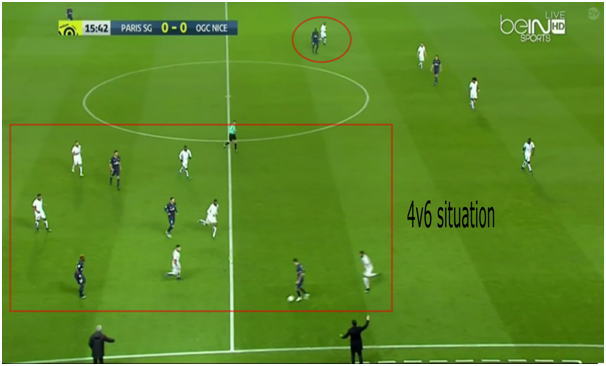
Scenario 4: Nice’s spatial overload in midfield
Though not as extreme as it was at Monchengladbach, Favre is gradually implementing his philosophy at Nice, with certain adaptations to ensure room for failure. As Di Maria receives on the right flank, Nice’s midfield trident has already shifted so far across the pitch their RCM-Seri, has drifted past the middle of the pitch. The aim? To force a backward pass away from goal, preventing PSG from advancing into the final third. However, the system still has imperfections while the players are adapting, as Walter’s body orientation here allows Aurier to receive in a comfortable position to switch play, which was what happened eventually. Favre ensures the LW-Matuidi is marked out by Pereira (red circle), while Cavani is marshalled by the defensive line, in the event the team in possession are able to play out of the spatial overload. Though they concede space in between the lines by having a deep defensive line, there are no PSG shirts to take advantage of the space, as Di Maria does not have a lateral option. Cavani could’ve dropped into the available space to receive, in this case.
Emery’s personnel change
Straight after the break, Emery brought on Lucas for Krychowiak on the left-wing, as Thiago Motta shifted to DM, while Matuidi dropped into his familiar LCM role. It instantly made a difference right after the restart.

Scenario 5: Nice’s poor defensive access as the ball is lost in PSG’s half
Motta receives immediately after Nice lost possession, exposing the league leaders’ lack of coverage in between the midfield-defence line. Lucas smartly drops into an advantageous position to receive; taking advantage of the space he is afforded. It was movements like these PSG were missing in the first half, from their front trio, which made it challenging for them to progress play into dangerous areas. Eventually, PSG retain possession in the centre of the pitch, allowing Verratti to play in Aurier, who made another well-timed run on the blind-side of Dalbert, delivering a low cross that Cavani converted, at last, to halve the deficit.
Before Lucas Moura’s introduction, PSG’s progression down the left-flank was limited to late runs from Kurzawa, as they mainly built their attacks from the opposite wing. Not only was Emery’s side were less predictable with Lucas on the pitch, his intelligent positioning and occupation of space improved their positional play in the final third.
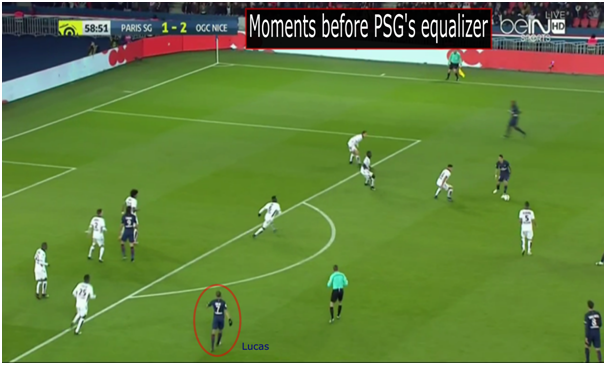
Scenario 6: Lucas’ intelligent movement – occupying the left half-space
Right before PSG’s equalizing goal, Lucas’ smart movement to occupy the left-halfspace exploited the shifting issues of Nice’s midfield unit, and provided Di Maria with a lateral passing option (though the ball did not go to him). His presence alone was enough to disorientate Pereira, creating space out wide for Kurzawa to burst forward and deliver the eventual cross that Cavani scored from.
Conclusion
A feisty encounter that lived up to its hype. As PSG go home rueing their missed chances, it’s back to the drawing board for Unai Emery, who will have to figure a way to find balance between having a structured attack, while allowing his star players freedom to combine in the final third. PSG flank-oriented build up focused heavily on using their fullback’s late runs to create crossing opportunities. Their over-reliance on Aurier and Kurzawa to penetrate down the flanks is another issue the 3-time Europa League winner will have to address.
Nice on the other hand, may be screaming at themselves for letting a comfortable 2-goal advantage slip from their hands, but a point ensured they remained top of Ligue 1, maintaining their 4-point lead over last season’s champions. While Le Aiglons showed little of their ability to keep the ball against top opposition, Lucien Favre’s space-oriented defensive approach was sufficient to keep PSG at bay, as Nice steadily start to develop a new, exciting brand of football under the Swiss manager’s tutelage.
Read all our tactical analyses here.
- Tactical Analysis: PSG 2-2 Nice | Nice hold on for a valuable point - December 19, 2016






















































